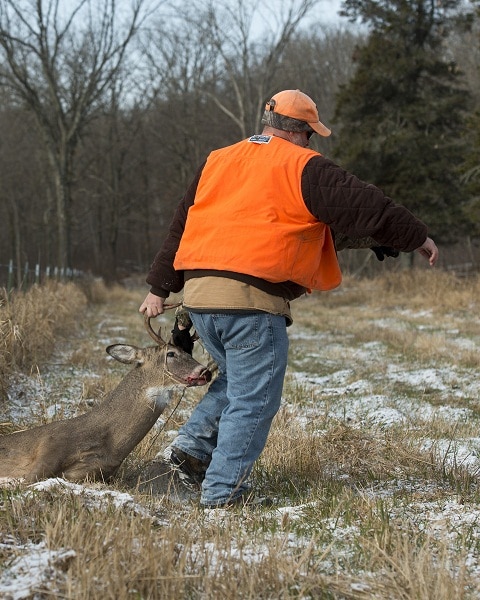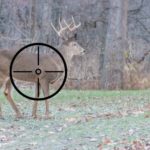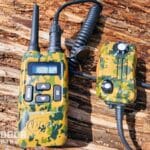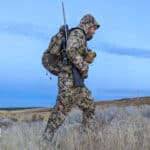In a perfect world, every deer you shot with your best hunting bow would go down where you could see it and they would never get up. However, hunters quickly learn that while this happens from time to time, it is often not how it plays out.
Sometimes, they only go a short distance but out of eyesight and other times they manage to go quite far, even while terminally hit.
Most hunters will experience some amount of anxiety and doubt as the animal runs off, even if they are pretty certain they hit the deer well.
The longer you have to track your deer or the more trouble you have finding signs of where the deer went, the more that anxiety grows.
Knowing some tips on tracking and recovering your hit deer will do a lot to alleviate that anxiety and increase your odds of a quick recovery.
Watching Your Shot
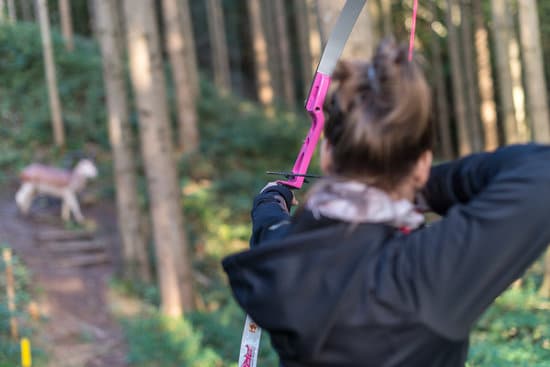
Bright fletchings or vanes on your arrow are a big help for watching the flight and seeing where the arrow hits the deer.
Many states have now legalized lighted nocks, which also help you see where the arrow hits, especially in low light conditions.
If possible, you want to observe not just where the arrow hits, but also how deep the arrow penetrates. A well-placed shot just behind the shoulder should be a double-lung shot and the deer will likely not go far before expiring.
Further reading: Where To Shoot A Deer: 6 Kill Zone Shot Placements w/ Graphics
If you are sure you have done that level of damage, you can start the tracking process a little sooner. If you think you may have hit farther back, only clipped one lung, or not gotten ideal penetration, you should wait longer before starting to track the deer.
Even if a deer is hit in a somewhat marginal spot, it will often not go far before bedding down. It may take it some time to expire, and starting to track it too soon may cause you to bump it from its bed.
Deer that are able to get back on their feet after being bumped have been known to travel for considerable distances, and it can often turn into a drawn-out tracking process.
You should also observe the reaction of the deer after the shot, which can give you some clues about what kind of hit it has taken.
Obviously, deer behavior will differ, so you should use deer reaction in conjunction with other indications to form your best guess as to where the deer is hit:
- A deer that has suffered a double lung injury will often run hard and fast for one or two hundred yards before falling dead.
- If the deer is hit in the heart, it is common for them to jump and mule kick before taking off on a fast, erratic run, which usually does not cover the distance of a lung-hit deer.
- A deer hit far back in the guts, intestines or liver may flinch at impact and then run a short distance with its head down before slowing and eventually bedding down.
- If you hit bone you will likely hear a distinct sound and may observe the deer favoring the leg you hit if that is the case.
- An alert deer that bounces off with its tail waving high, stopping and looking back to where it came from is often indicative of a clean miss.
Scouring the Location of the Shot

Even moving the distance from where you shot to where the deer was could be enough to bump the deer if it bedded down inside of 100 yards.
Some hunters will wait several hours if the deer is hit far back, some will back out of the area and return the next morning.
Whether you have waited hours to go check the area, or whether you are confident in a good hit and waited just a short time to go check the scene, make mental notes of where the deer was when you shot it.
Walk to that spot and start looking for signs like blood, hair, bone fragments and your arrow. You should combine what you find here with your observations so far to start forming a better idea of exactly what the shot did.
Arrow – If you find your arrow, you can examine it for the type of blood and matter that is on it. You can also see how much of the arrow has blood on it to determine how far it penetrated.
An arrow that is covered in blood, including the fletchings or vanes, was a complete pass through. An arrow with no blood, hair or guts on it was a clean miss. If the arrow has blood on 20 inches of the shaft, that is how far the arrow penetrated.
Blood – Whether it is on the arrow, the ground, or surrounding brush, the blood itself will also give you some hints about where the deer was hit.
Pink and foamy blood is a good indication of a lung or a heart shot. If the blood is very dark colored, it is likely a liver shot.
Lack of blood but presence of brown and watery fluids are signs of a gut shot. You should also be able to smell the stomach contents if you hit it too far back.
Hair – The hair you find can also help indicate where the deer was hit. If you find longer brown hairs you probably hit the deer forward near the vitals.
If the hair is shorter and brown, there is a better chance you hit it farther back. If you find white hairs and not much blood, you may have hit it low or forward, superficially.
Following the Trail
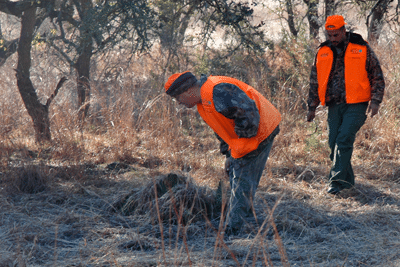
Even on a heart shot deer, some hunters wait an hour unless they actually observe it expiring. This is going to differ a little with each hunter and a lot by scenario. We will discuss some of the external factors to consider a little later.
After the wait is over, it is time to start tracking the deer. At this point, it never hurts to have friends there to help, especially if you are concerned about how well the deer is hit.
Even if the recovery is quick, at least you will have friends there to help with the work of getting your deer out of the woods or field.
The most obvious sign to follow is the blood trail. If you are able to continuously find drops of blood, that will be the easiest way to track the deer.
Even if the trail starts out very obvious, make sure to mark your path with flagging, toilet paper or some other system so you can circle back to the last known spot if you lose the trail.
Of course, the blood trail is not always that obvious. If there is not a lot of blood, you will have to look for other indications like tracks, disturbed dirt, and leaves, broken branches, etc.
If you have multiple people looking, a couple guys scouring the identified trail and a couple grid searching the flanks of the trail may be helpful.
As you follow the trail, keep some things in mind. The direction of the deer’s travel should be indicated by the pointed end of the blood drops on the ground if they form that way.
Many hit deer go downhill or head for thick brush if they are going to bed down. A gut shot deer is very likely to try to find water, so keep that in mind if you end up having to guess which direction it headed.
Remember to not just stare at the ground while you track. Scan everything from very close to farther away. This gives you a chance to spot the deer farther out or see signs of its movement that may be tricky to pick out at close range.
If the Trail is Lost
If you lose the blood trail or tracks, you are definitely going to want help if you can get it.
Your best bet at that point is to go to the last known location (hopefully marked by flagging or perhaps your GPS) and start making circles from there of increasing size.
While the temptation may be to continue moving farther away from the initial shot location, do not discount the areas back where you came from.
It is not uncommon for animals to circle back, double back or for you to miss a turn they made earlier in the tracking process.
Other Tracking Factors

Weather is a huge one of these factors. Some weather scenarios to take into consideration are:
1. If it is pouring down rain blood trails and tracks may get washed away quickly. You will probably need to start the tracking process sooner than later.
2. Snow can be great for tracking because hoof prints and blood both show up well… unless it is actively snowing hard. If the snow is coming down you might have to risk bumping the deer, knowing that you should be able to track its prints in the snow.
3. The temperature will also be a factor. If it is very warm you might need to try to recover the animal within a couple hours to save the meat from spoiling. If the weather is very cold, you have a little bit of leeway because the animal should start cooling as soon as it dies.
You may also have to take into consideration predators in the area. If you are in an area with bold coyotes or bears, you may not be able to let the deer sit for long, lest something else come along and eat it.
In other situations, you might want to give the deer extra time to expire where it is presumably bedded because the harm in bumping it is exasperated by the potential for it to move onto adjacent property that you do not have access to.
As you can see, there are a lot of factors that could go into the recovery process and you should make sure to think through them as the situation transpires.
Conclusion
Hopefully, by applying these tips to your situation you are able to successfully improve your tracking skills.
The thought of not recovering an animal is the lowest imaginable feeling for most hunters and the one that this article hopes to help you avoid.
Remember to take ethical shots within in your competency level at the onset and be patient and observant during the tracking process. That combination should provide many seasons of positive results.
Related: How Long After Shooting a Deer Do You Have to Gut It?

